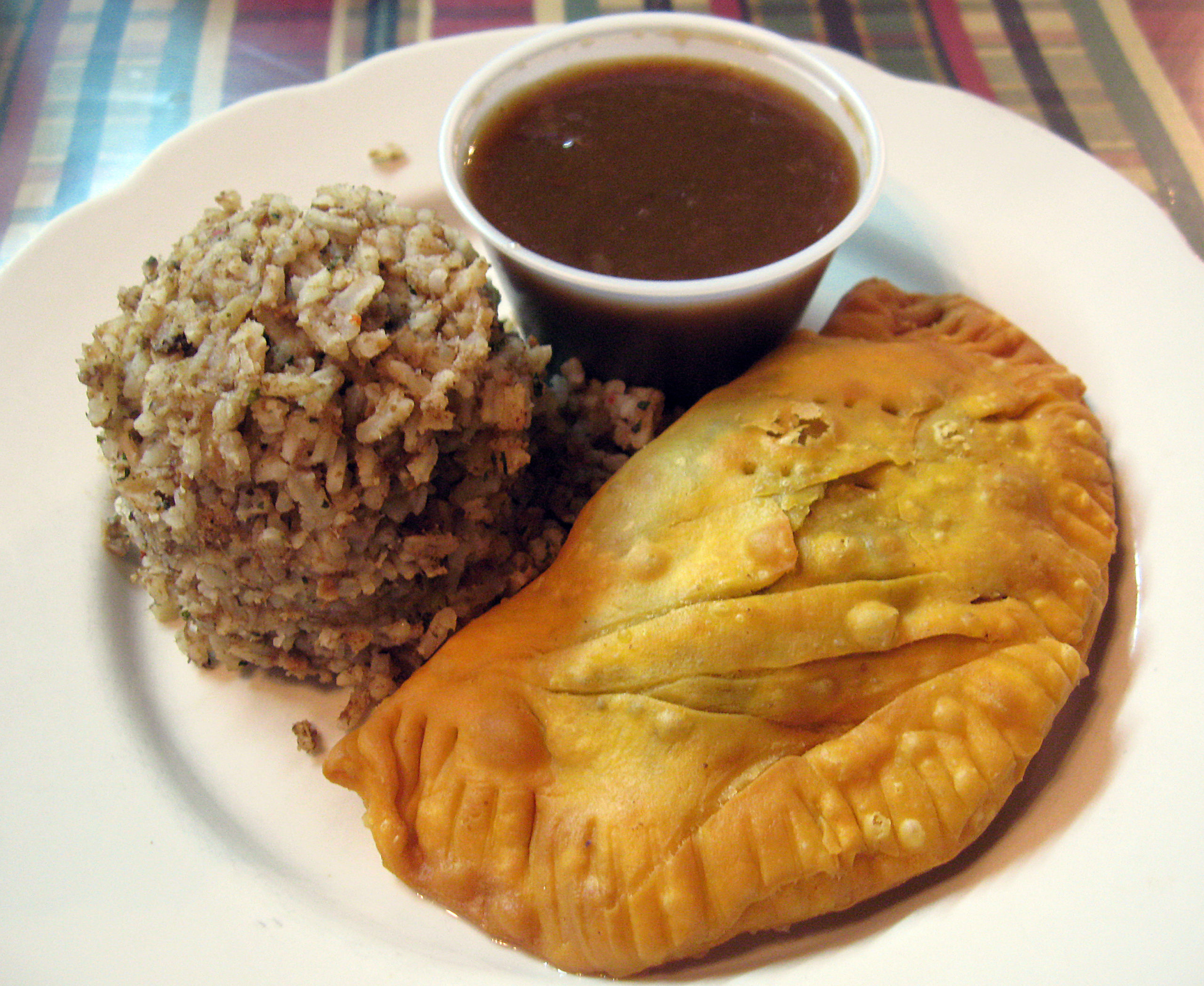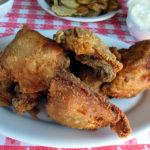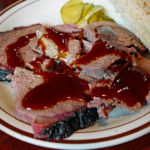Lasyone’s Meat Pie Kitchen
James Lasyone remembers that a quarter century ago, if you wanted to buy a meat pie in Natchitoches (pronounced nack-uh-tush), you needed to cozy up to one of the women who prepared the local delights in their home kitchens for sale. Unless you knew a pie maker, and were on her preferred customer list, you didn't have a prayer. "She might take care of you if you were recommended by a regular patron," Mr. Lasyone explains. "But those ladies didn't make pies for just anyone who called on them." This was a situation that deeply disturbed Mr. Lasyone, who grew up near the old Red River community in the 1940s and remembered meat pies as one of the fundamental foods of his youth. He tells of the days when they were sold on street corners from white buggies pushed by little boys who would chant to advertise the freshness and savoriness of their victuals and who kept their pies warm over small wood fires, perfuming the avenues with the fragrance of seasoned pork and beef in a fried pastry crust.

By Jane and Michael Stern
Originally Published 1996 Gourmet Magazine
James Lasyone remembers that a quarter century ago, if you wanted to buy a meat pie in Natchitoches (pronounced nack-uh-tush), you needed to cozy up to one of the women who prepared the local delights in their home kitchens for sale. Unless you knew a pie maker, and were on her preferred customer list, you didn’t have a prayer. “She might take care of you if you were recommended by a regular patron,” Mr. Lasyone explains. “But those ladies didn’t make pies for just anyone who called on them.” This was a situation that deeply disturbed Mr. Lasyone, who grew up near the old Red River community in the 1940s and remembered meat pies as one of the fundamental foods of his youth. He tells of the days when they were sold on street corners from white buggies pushed by little boys who would chant to advertise the freshness and savoriness of their victuals and who kept their pies warm over small wood fires, perfuming the avenues with the fragrance of seasoned pork and beef in a fried pastry crust.
“I cannot explain for certain how meat pies first came to this place,” Mr. Lasyone says, suggesting that it might have happened well over a century ago, when Natchitoches (founded in 1714, the oldest European settlement in the Louisiana Purchase) was a thriving port and an outfitting station for settlers heading west. It is possible, he speculates, that the meat pie made its appearance in those days, before the river shifted course away from town. “I believe it was cooks on boats from far away who made the meat pies. People in town liked them, learned how to make them, and never forgot them.”
By the middle of the twentieth century, however, street-corner pie vendors were fading into the past. James Lasyone, who was born a sharecropper’s son out in the country and had enjoyed the pies when his family came to town, became the butcher at a grocery store on Second Street. When he wanted a meat pie he knew which ladies to call. “Some were white, some were black,” he remembers. “But there weren’t many left.” In the mid-1960s, he began experimenting with recipes to make his own pies. He sold some over the butcher’s counter at the store, and in 1967 he opened Lasyone’s Meat Pie Kitchen near the meat market, in a minuscule retail space that had housed a finance company. You could buy his meat pies to take home and fry, and he also made some on premises, ready to eat.
“See that little old pot over there?” he asks, pointing to a cast iron kettle displayed on a shelf in the dining room of his restaurant. “That’s all I started with. That, and a six dollar and ninety-five cent investment in groceries.” Lasyone’s place has since become a Southern food landmark, and the walls of its vestibule are decorated with testimonials by friends and admirers as a tribute to its fame. There is a picture of Mr. Lasyone (who rhymes his last name with “jazzy-bone”) with Vanna White and another with Daryl Hannah. Cindy Williams came to eat meat pie and left an autographed photo, as did Doc Severinson, Lorne Greene, and the Kentucky Headhunters (a heavy metal—country band).
The meat pie that has attracted all this attention is a national treasure. As prepared by Mr. Lasyone, it is hearty yet elegant. A half-circle-shaped pastry pocket about the size of a taco, with a rugged crimp around its edges, the pie has a golden crust that is brittle and crunchy near the crimp and soft and tawny near its mounded center. Inside this flaky sheaf is a good-sized portion of deftly seasoned ground beef and pork, moist enough to make gravy irrelevant. Complex and succulent, spicy but not fiery-hot, Lasyone’s meat pie is an honest piece of food that satisfies in an old-fashioned way. You can get one for breakfast, accompanied by eggs and hash browns; but most steady customers come at midday to have a pair of them for lunch with soulful “dirty rice” on the side, darkened with plenty of giblets and topped with zesty gravy.
Lasyone’s has grown from a bare snack shop into a snug, casual lunchroom open at seven A.M. and closing at seven P.M., when people take their meat pies home for supper. It is located in a stately down-town building more than a century old, with red awnings above second-story windows and a giant plaster model of a meat pie hanging in Lasyone’s storefront display of kitchen antiques. Inside, on tables covered with floral-print cloths and easy-wipe glass, silverware arrives wrapped in paper napkins and the condiment selection includes a bottle of Louisiana hot sauce. Ceiling fans circulate overhead, and the air is faintly scented with the pepper and spice of swampland cookery.
The pleasure of a meal at Lasyone’s is amplified by the history that pervades the town. Nearby Front Street, which faces the banks of clear Cane River Lake where paddle-wheelers once docked, is still paved with bricks and lined with shops that have upper-level porches festooned with lacy wrought-iron fleurs de lis. The antebellum plantation houses and gardens around Natchitoches are some of the most beautiful in the South. In this environment a meat pie at Lasyone’s has the taste of edible history. (At the annual Northwestern State University of Louisiana Folk Festival in July, Mr. Lasyone sells some three thousand of his meat pies. Not only are they excellent fair food, wieldy enough to eat without utensils, they are also authentic “folk food.”)
Although meat pies are its main claim to fame, Lasyone’s also happens to be an exemplary place to savor all manner of regional delights. Some dishes are enthusiastically spiced to reflect the French and Spanish traditions on which Creole cooking was built, but, in addition to these brightly seasoned specialties, the menu always lists a delectable roster of Southern hallmarks, from biscuits and grits in the morning to crisp-fried catfish and chicken-and-dumpling stew at noon. Many regulars, apparently blasé about the allure of meat pie, come to Lasyone’s simply because it is the best place in town for a quick, inexpensive meal in a pleasant setting: a breakfast of ham (sliced thick or thin) and eggs, with grits on the side, or a hot lunch such as liver smothered with onions or chicken-fried steak with plenty of gravy.
Mr. Lasyone is the kind of chef who delights in creating things. When we spoke with him he was in the midst of developing a chicken-and-spaghetti dish. “I have three good recipes,” he said, “but not one of them is exactly right. So I’m taking a little of this from that one and a little of that from this one, and I think I’ll come up with one that is exactly right.” Whatever he finally develops, you can be sure it will be a meal with character, not for gastronomic featherweights. “There are people who tell me they cannot eat garlic,” he puzzles. “I do not understand that. To me, garlic is a medicine. The best medicine there is.”
You will savor a good measure of the stinking rose in the jambalaya that is one of his acclaimed wintertime preparations and in his file gumbo, too. Red beans are always on the menu, available with or without sausage. The plain beans, uncharacteristically for this place, are a mellowed version of the traditional dish, made without any ham bone or sausage whatsoever—mild-tasting, tender, and comforting to eat. Explaining his beans’ nutritional chastity, an incredulous Mr. Lasyone says, “A lot of people don’t want pork in their diet. They worry so much about what they eat that they suffer from a lack of enjoyment.”
A robust man who clearly has little trouble enjoying food, Mr. Lasyone attributes his culinary skills to his mother. “Your food choices are limited when you are a sharecropper,” he says. “So you learn to invent things; you develop the habit of making the most of what you have. To be a good cook, you have to want to create something when you see a handful of ingredients.” To illustrate his point, he tells how, not long ago, he invented Cane River pie, a dessert that has become nearly as renowned as his meat pie. “One day I was making twenty-two strawberry short-cakes. I had all my ingredients lined up on the counter, but someone in the kitchen had left a glass of chocolate milk nearby. I accidently poured it in the batter. At first I was mad, but then I thought, This is interesting. After that, I fiddled and I fussed and I played with the idea, and I believe I finally got it right.”
The Cane River pie that ultimately resulted from his experiments has no chocolate milk in the batter, but it does have chocolate syrup poured on top of two layers of gingerbread that sandwich a thin layer of custard. The sauce seeps into the cake and creates moist, fudgy streaks in the gingerbread. A slice of Cane River pie vaguely resembles a Boston cream pie, but one that is dark and spicy and wickedly sweet—a set of qualities especially well suited to the conclusion of a meal in the bayous of Louisiana.
Discuss
What do you think of Lasyone’s Meat Pie Kitchen?
Related Articles
Stroud’s
By Jane and Michael Stern Originally Published 1995 Gourmet Magazine Chicken...
The Lobster Roll Honor Roll
Maine is the only state in America that features a picture of cooked food on its license...
Meat-And-Three
A few years back, country singer Ray Stevens invited a New York friend to join him at one of...
Top 12 favorite Ice Cream Scoops
WITH THE EXCEPTION of the hot dog bun, there has never been an edible invention as...
Top 5 BBQ Restaurants | Western Kentucky
Get yourself to Western Kentucky for great BBQ I see the food shows on TV where...
Best restaurants in Greenwood, MS | Hot Licks Delta Style
Ever since we first ate margarine-sauced pompano at Lusco’s, in Greenwood,...






